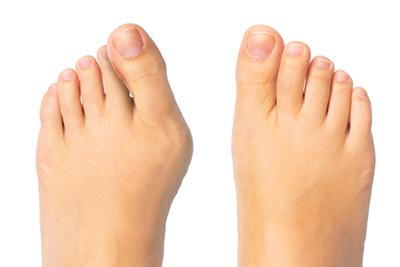
Get in touch with Dr. Peter Caldwell of Iowa Foot & Ankle Clinic if you need treatment for bunions in Cedar Rapids, IA.
What Are Bunions?
Our feet are constantly subjected to pressure and stress. While this typically causes nothing more than temporary discomfort, it can also lead to long-term issues. For example, injuries or unsuitable footwear may result in the development of bunions.
A bunion is a bony growth that forms near the big toe. It’s hard to miss because it changes the appearance of your foot. Your big toe may shift toward your smaller toes. Meanwhile, the base of your big toe joint might move in the opposite direction and start to jut out.
A lot of people don’t like how bunions look, but the changes they make to the appearance of your feet may not be the full extent of your worries. The bigger issue could be the discomfort caused by bunions. This pain can also worsen over time. As bunions grow, you may struggle to walk or even wear shoes.
So, why have your feet developed bunions? The two main contributing factors are genetics and excessive foot pressure.
You may be more susceptible to bunions due to the shape of your feet. People with a family history of bunions are also more likely to develop these bony growths.
Meanwhile, excessive pressure may be related to your choice of footwear. If your shoes are too tight around your big toes, they might cause bunions to form. Prior injuries can also put more pressure on your feet.
You can obtain effective treatment for bunions in Cedar Rapids, IA, after consulting with Dr. Caldwell of Iowa Foot & Ankle Clinic.
How Will a Podiatrist Treat Your Bunions?
The primary goal of bunion treatment is to ease the pressure on your big toe. A podiatrist can reduce that pressure by utilizing various treatment methods.
First off, your podiatrist may ask you to wear different shoes so that your feet can move around more comfortably. If you’re having trouble finding suitable shoes, the podiatrist might recommend wearing sandals.
Podiatrists may also prescribe orthotics when treating bunions. Orthotics are helpful because they can decrease the pressure on your big toe joints when you’re wearing shoes. They also make it easier for you to walk comfortably.
If your bunion remains a problem even after you switch to new shoes or use orthotics, your podiatrist might suggest surgery as a treatment option. Through surgery, a podiatrist can realign your big toe and remove the bunion.
Learn more about the available treatments for bunions in Cedar Rapids, IA, by calling 319-363-3543 and speaking to Dr. Caldwell of Iowa Foot & Ankle Clinic.
